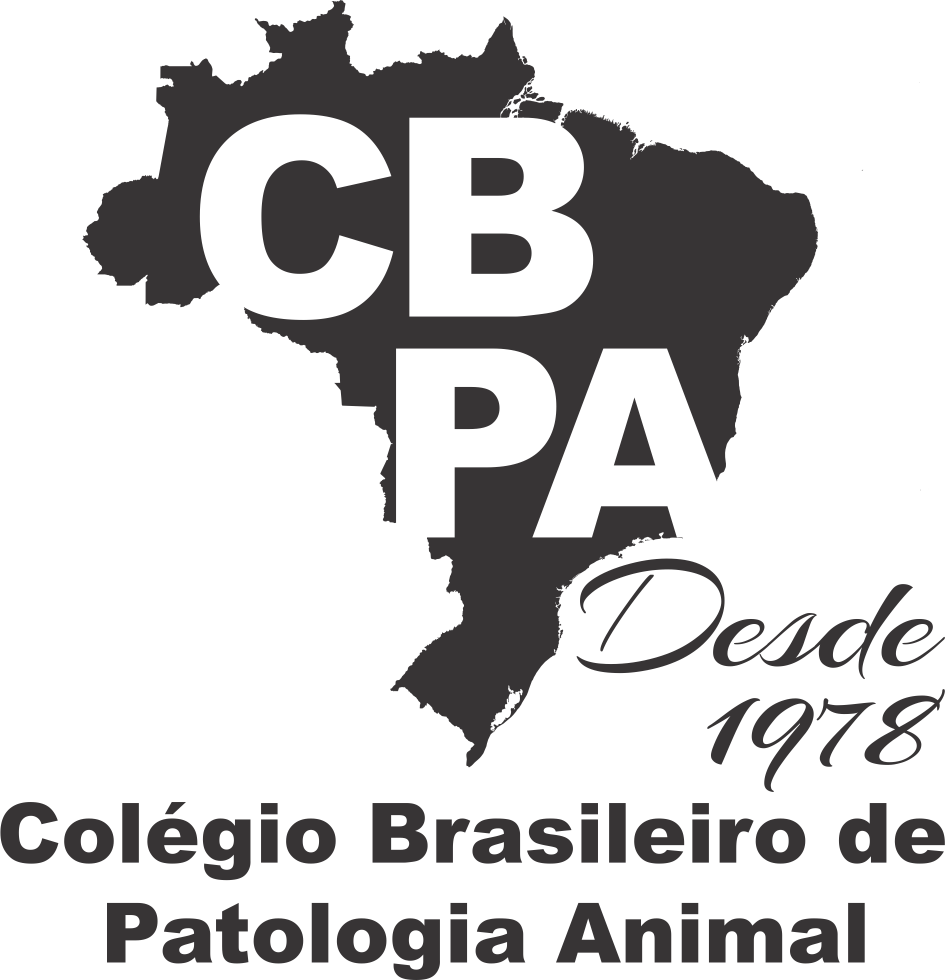Resultado da pesquisa (51)
Termo utilizado na pesquisa Souza M.
#41 - Poisoning by Stryphnodendron fissuratum (Mimosoideae) in cattle, 29(11):951-957
Abstract in English:
ABSTRACT.- Ferreira E.V., Boabaid F.M., Arruda L.P., Lemos R.A.A, Souza M.A., Nakazato L. & Colodel E.M. 2009. [Poisoning by Stryphnodendron fissuratum (Mimosoideae) in cattle.] Intoxicação por Stryphnodendron fissuratum (Mimosoideae) em bovinos. Pesquisa Veterinária Brasileira 29(11)951-957. Departamento de Clínica Médica Veterinária, Faculdade de Agronomia e Medicina Veterinária, Universidade Federal de Mato Grosso, Cuiabá, MT 78068-900, Brazil. E-mail: moleta@ufmt.br
Epidemiological, clinical and pathological aspects of natural and experimental Stryphnodendron fissuratum poisoning in cattle in Central-Western Brazil were evaluated. The coiled pods of this tree are popularly known as “rosquinha” (small coil); they mature during July-September, when they fall to the ground, and are consumed by cattle causing mortalities. Spontaneous outbreaks of poisoning were investigated in the municipalities of Aruanã, State of Goias, Guiratinga and Rondonópolis State of Mato Grosso, and Rio Verde de Mato Grosso, State of Mato Grosso do Sul. Commonly the poisoning occurred in properties with Nelore cattle herds, which were raised extensively on Brachiaria spp. pastures. The clinical course in natural cases ranged from 24 hours to 10 days, and the morbidity and case fatality rates were 0.9-25% and 15-100%, respectively. The main clinical signs in the spontaneous poisoning were apathy, anorexia, agressiveness, jaundice, sialorrhoea, incoordination, dysmetria, retraction of the abdomen, uneasiness and pasty black feces with stings of mucus or blood, diarrhea, edema of the dewlap and photosensitization. At necropsy, jaundice, edema of the subcutaneous tissue, mainly of the cervical region, hemorrhages of serous membranes, ascitis and hidrotorax, edema of the mesentery, perirenal edema, increased size of liver and kidney, reddening of the ruminal mucosa, and abomasum ulcers were observed. The diagnosis of S. fissuratum poisoning was based on epidemiological, clinical and pathological findings, and in the experimental reproduction by the administration of the pods of this plant to cattle. Experimentally, daily doses of 4 and 20g of pods by kg body weight, respectively, were administered to two bovines. Both animals had digestive signs and died, but photosensitization was not observed.
Abstract in Portuguese:
RESUMO.- Ferreira E.V., Boabaid F.M., Arruda L.P., Lemos R.A.A, Souza M.A., Nakazato L. & Colodel E.M. 2009. [Poisoning by Stryphnodendron fissuratum (Mimosoideae) in cattle.] Intoxicação por Stryphnodendron fissuratum (Mimosoideae) em bovinos. Pesquisa Veterinária Brasileira 29(11)951-957. Departamento de Clínica Médica Veterinária, Faculdade de Agronomia e Medicina Veterinária, Universidade Federal de Mato Grosso, Cuiabá, MT 78068-900, Brazil. E-mail: moleta@ufmt.br
Descrevem-se aspectos epidemiológicos, clínicos e patológicos da intoxicação natural por Stryphnodendron fissuratum em bovinos na região Centro-Oeste do Brasil. Esta planta possui favas retorcidas, conhecidas popularmente por “rosquinha”, que amadurecem entre julho e setembro, caem ao solo e são consumidas por bovinos, sendo relacionadas com mortalidades. Foram investigados surtos de intoxicação espontânea que ocorreram nos municípios de Aruanã, GO, Guiratinga e Rondonópolis, MT e Rio Verde de Mato Grosso, MS. Em geral, a intoxicação ocorreu em propriedades de pecuária extensiva, com rebanhos da raça Nelore e em pastagens de Brachiaria spp. Nos casos naturais, a evolução clínica variou em média de 24 horas até 10 dias e a morbidade e a letalidade variaram de 0,9 a 25% e de 15 a 100%, respectivamente. Os principais sinais clínicos na intoxicação natural foram depressão, anorexia, agressividade, icterícia, sialorréia, incoordenação motora, dismetria, retração abdominal, inquietação, fezes pastosas enegrecidas ou ressequidas com muco e estrias de sangue, diarréia, edema de barbela e fotossensibilização. À necropsia havia icterícia, edema do tecido subcutâneo, principalmente na região cervical, petéquias e equimoses de serosas abdominais e torácicas, ascite e hidrotórax leves, edema do mesentério, edema perirrenal, aumento do volume de fígado e rim, avermelhamento ruminal e úlceras multifocais no abomaso. O exame histológico revelou lesões degenerativas e necrose no fígado e rim e no abomaso áreas de necrose na mucosa. O diagnóstico de intoxicação por S. fissuratum foi estabelecido com base nos achados epidemiológicos, clínicos, patológicos e, em parte, na reprodução experimental pela administração das favas desta planta para bovinos. Em dois bovinos que receberam, respectivamente, duas doses diárias de 4 e 20 g de favas por kg de peso vivo foram observados sinais digestivos e morte dos animais, mas não ocorreu fotossensibilização.
#42 - Virulence factors and antimicrobial resistance in Staphylo-coccus aureus isolated from bovine mastitis in Rio de Janeiro, p.369-374
Abstract in English:
ABSTRACT.- Coelho S.M.O., Reinoso E., Pereira I.A., Soares L.C., Demo M., Bogni C & Souza M.M.S. 2009. Virulence factors and antimicrobial resistance in Staphylo-coccus aureus isolated from bovine mastitis in Rio de Janeiro. Pesquisa Veterinária Brasileira 29(5):369-374. Departamento de Microbiologia e Imunologia Veterinária, Instituto de Veterinária, Universidade Federal Rural do Rio de Janeiro, Seropédica, RJ 23890-000, Brazil. E-mail: miliane@ufrrj.br
The study was conducted to characterize pheno-genotypically the virulence factors and resistance pattern of Staphylococcus aureus isolates from milk samples of cows with subclinical mastitis. All hemolytic isolates presented beta-hemolysin, and 38% of the non-hemolytic isolates were able to express hemolysins in the presence of a beta-hemolytic strain. The amplification of the coa-gene displayed four different size polymorphisms with about 400 bp, 600 bp, 700 bp and 900 bp. The spaA gene that encodes the IgG-binding region of protein A revealed sizes of 700 bp and 900 bp. The amplification of region X from spaA yielded a single amplicon for each isolate with the prevalent amplicon size being of 180 bp. Amplification of sae gene yielded an amplicon size of 920 bp in 71% of the isolates. Antibiotic resistance pattern revealed that 42% S. aureus were susceptible to all antimicrobials tested. Seven different antibiotic patterns were observed. Our results indicated that 47% and 25% of S. aureus strains exhibited resistance to penicillin and oxacillin respectively. All oxacillin-resistant isolates were mecA-positive.
Abstract in Portuguese:
ABSTRACT.- Coelho S.M.O., Reinoso E., Pereira I.A., Soares L.C., Demo M., Bogni C & Souza M.M.S. 2009. Virulence factors and antimicrobial resistance in Staphylo-coccus aureus isolated from bovine mastitis in Rio de Janeiro. Pesquisa Veterinária Brasileira 29(5):369-374. Departamento de Microbiologia e Imunologia Veterinária, Instituto de Veterinária, Universidade Federal Rural do Rio de Janeiro, Seropédica, RJ 23890-000, Brazil. E-mail: miliane@ufrrj.br
The study was conducted to characterize pheno-genotypically the virulence factors and resistance pattern of Staphylococcus aureus isolates from milk samples of cows with subclinical mastitis. All hemolytic isolates presented beta-hemolysin, and 38% of the non-hemolytic isolates were able to express hemolysins in the presence of a beta-hemolytic strain. The amplification of the coa-gene displayed four different size polymorphisms with about 400 bp, 600 bp, 700 bp and 900 bp. The spaA gene that encodes the IgG-binding region of protein A revealed sizes of 700 bp and 900 bp. The amplification of region X from spaA yielded a single amplicon for each isolate with the prevalent amplicon size being of 180 bp. Amplification of sae gene yielded an amplicon size of 920 bp in 71% of the isolates. Antibiotic resistance pattern revealed that 42% S. aureus were susceptible to all antimicrobials tested. Seven different antibiotic patterns were observed. Our results indicated that 47% and 25% of S. aureus strains exhibited resistance to penicillin and oxacillin respectively. All oxacillin-resistant isolates were mecA-positive.
#43 - Compactação primária do abomaso em 14 bovinos no Estado de Pernambuco, p.387-394
Abstract in English:
ABSTRACT.- Câmara A.C.L., Afonso J.A.B., Costa N.A., Mendonça C.L. & Souza M.I. 2009. [Primary abomasal impaction in 14 cattle from Pernambuco State, northeastern Brazil.] Compactação primária do abomaso em 14 bovinos no Estado de Pernambuco. Pesquisa Veterinária Brasileira 29(5):387-394. Clínica de Bovinos, Campus Garanhuns, Universidade Federal Rural de Pernambuco, Av. Bom Pastor s/n, Cx. Postal 152, Mundaú, Garanhuns, PE 55292-901, Brazil. E-mail: aclcamara@yahoo.com.br
Despite the frequent use of dry and fibrous roughage for feeding cows in many regions, especially during the dry season, impaction of the abomasum has been poorly reported in Brazil, probably because the condition is misdiagnosed by practitioners. The present paper aimed to accomplish a retrospective study on primary abomasal impaction in 14 cattle from Pernambuco State, northeastern Brazil. Eight moderate cases, without severe abdominal distention and with no rumen compaction, were treated conservatively, and four severe cases, with severe abdominal distention and rumen compaction, were treated surgically. One bull was slaughtered and one cow died without treatment. The greater number of abomasal impaction cases was in Holstein cows with six cases (42.9%), followed by crossbred cattle with five cases (35.8%), and the breeds Brown-Swiss, Nelore and Marchigiana, each with one case (21.3%). The food composition was characterized by low quality fibers and varied greatly among cases. Most frequent clinical signs were apathy, dehydration, hypomotility and ruminal bloat, intestinal hypomotility and scanty or absent feces with mucus. The hematological findings revealed leukocytosis with neutrophilia and hyperfibrinogenemia in most cases. Ruminal fluid analysis showed compromised flora and fauna dynamics and increased chlorine ion concentration. Clinical (4/8) and chirurgical (2/4) recovery rate achieved 50%. The clinical and chirurgical methods remain as viable options for the treatment of light and severe impaction, but the prognosis is always reserved especially when associated to late pregnancy.
Abstract in Portuguese:
ABSTRACT.- Câmara A.C.L., Afonso J.A.B., Costa N.A., Mendonça C.L. & Souza M.I. 2009. [Primary abomasal impaction in 14 cattle from Pernambuco State, northeastern Brazil.] Compactação primária do abomaso em 14 bovinos no Estado de Pernambuco. Pesquisa Veterinária Brasileira 29(5):387-394. Clínica de Bovinos, Campus Garanhuns, Universidade Federal Rural de Pernambuco, Av. Bom Pastor s/n, Cx. Postal 152, Mundaú, Garanhuns, PE 55292-901, Brazil. E-mail: aclcamara@yahoo.com.br
Despite the frequent use of dry and fibrous roughage for feeding cows in many regions, especially during the dry season, impaction of the abomasum has been poorly reported in Brazil, probably because the condition is misdiagnosed by practitioners. The present paper aimed to accomplish a retrospective study on primary abomasal impaction in 14 cattle from Pernambuco State, northeastern Brazil. Eight moderate cases, without severe abdominal distention and with no rumen compaction, were treated conservatively, and four severe cases, with severe abdominal distention and rumen compaction, were treated surgically. One bull was slaughtered and one cow died without treatment. The greater number of abomasal impaction cases was in Holstein cows with six cases (42.9%), followed by crossbred cattle with five cases (35.8%), and the breeds Brown-Swiss, Nelore and Marchigiana, each with one case (21.3%). The food composition was characterized by low quality fibers and varied greatly among cases. Most frequent clinical signs were apathy, dehydration, hypomotility and ruminal bloat, intestinal hypomotility and scanty or absent feces with mucus. The hematological findings revealed leukocytosis with neutrophilia and hyperfibrinogenemia in most cases. Ruminal fluid analysis showed compromised flora and fauna dynamics and increased chlorine ion concentration. Clinical (4/8) and chirurgical (2/4) recovery rate achieved 50%. The clinical and chirurgical methods remain as viable options for the treatment of light and severe impaction, but the prognosis is always reserved especially when associated to late pregnancy.
#44 - Intoxicação espontânea por vagens de Prosopis juliflora (Leg. Mimosoideae) em bovinos em Pernambuco, p.233-240
Abstract in English:
ABSTRACT.- Câmara A.C.L., Costa N.A., Riet-Correa F., Afonso J.A.B., Dantas A.F.M., Mendonça C.L. & Souza M.I. 2009. [Spontaneous poisoning in cattle by mesquite beans, Prosopis juliflora (Leg. Mimosoideae) in Pernambuco.] Intoxicação espontânea por vagens de Prosopis juliflora (Leg. Mimosoideae) em bovinos em Pernambuco. Pesquisa Veterinária Brasileira 29(3):233-240. Clínica de Bovinos, Campus Garanhuns, Universidade Federal Rural de Pernambuco, Av. Bom Pastor s/n, Cx. Postal 152, Mundaú, Garanhuns, PE 55292-901, Brazil. E-mail: aclcamara@yahoo.com.br
Three outbreaks of poisoning by Prosopis juliflora pods are reported in the semiarid region of the state of Pernambuco, Northeastern Brazil, in cattle grazing in fields invaded by the plant or ingesting mesquite beans as a concentrate food. In two farms the disease occurred sporadically. In another, 112 (9.28%) cattle out of 1206 were affected, 84 (6.96%) died due to emaciation, and 28 (2.32%) gained weight after the pods had been withdrawn from the feed. Main clinical signs were progressive weight loss, atrophy of the masseter muscles, dropped jaw, tongue protrusion, difficulties in prehending food, tilting the head during mastigation or rumination, salivation, impaired swallowing, and decreased tone of the tongue. The hematology reveals hypoproteinemia and anemia. Gross lesions were emaciation and reduction in size of the masseter muscles, which appear thinner than normal and grayish due muscular atrophy. Degeneration of neurons of the trigeminal motor nuclei, Wallerian degeneration of the trigeminal nerve roots, and muscular atrophy of the masseter muscles with substitution by fibrous tissue were observed on histologic examination. For the prevention of the poisoning is necessary to limit the amount of mesquite beans in animal nutrition. It is also necessary to develop research to determine the economic and sustainability of the use of Prosopis juliflora for animal food, human food or other uses such as charcoal, wood and fuel wood.
Abstract in Portuguese:
ABSTRACT.- Câmara A.C.L., Costa N.A., Riet-Correa F., Afonso J.A.B., Dantas A.F.M., Mendonça C.L. & Souza M.I. 2009. [Spontaneous poisoning in cattle by mesquite beans, Prosopis juliflora (Leg. Mimosoideae) in Pernambuco.] Intoxicação espontânea por vagens de Prosopis juliflora (Leg. Mimosoideae) em bovinos em Pernambuco. Pesquisa Veterinária Brasileira 29(3):233-240. Clínica de Bovinos, Campus Garanhuns, Universidade Federal Rural de Pernambuco, Av. Bom Pastor s/n, Cx. Postal 152, Mundaú, Garanhuns, PE 55292-901, Brazil. E-mail: aclcamara@yahoo.com.br
Three outbreaks of poisoning by Prosopis juliflora pods are reported in the semiarid region of the state of Pernambuco, Northeastern Brazil, in cattle grazing in fields invaded by the plant or ingesting mesquite beans as a concentrate food. In two farms the disease occurred sporadically. In another, 112 (9.28%) cattle out of 1206 were affected, 84 (6.96%) died due to emaciation, and 28 (2.32%) gained weight after the pods had been withdrawn from the feed. Main clinical signs were progressive weight loss, atrophy of the masseter muscles, dropped jaw, tongue protrusion, difficulties in prehending food, tilting the head during mastigation or rumination, salivation, impaired swallowing, and decreased tone of the tongue. The hematology reveals hypoproteinemia and anemia. Gross lesions were emaciation and reduction in size of the masseter muscles, which appear thinner than normal and grayish due muscular atrophy. Degeneration of neurons of the trigeminal motor nuclei, Wallerian degeneration of the trigeminal nerve roots, and muscular atrophy of the masseter muscles with substitution by fibrous tissue were observed on histologic examination. For the prevention of the poisoning is necessary to limit the amount of mesquite beans in animal nutrition. It is also necessary to develop research to determine the economic and sustainability of the use of Prosopis juliflora for animal food, human food or other uses such as charcoal, wood and fuel wood.
#45 - Plasma rico em plaquetas no tratamento de tendinite induzida em eqüinos: avaliação ultra-sonográfica, p.241-245
Abstract in English:
ABSTRACT.- Maia L., Souza M.V., Alves G.E.S., Júnior J.I.R., Oliveira A.C., Silva Y.F.R.S. & Zandim B.M. 2009. [Platelet-rich plasma in the treatment of induced tendinitis in equines: Ultrasonographic evaluation.] Plasma rico em plaquetas no tratamento de tendinite induzida em eqüinos: avaliação ultra-sonográfica. Pesquisa Veterinária Brasileira 29(3):241-245. Setor de Clínica e Cirurgia de Grandes Animais, Departamento de Veterinária, Universidade Federal de Viçosa, 36570-000 Viçosa, MG, Brazil. E-mail: msouza@ufv.br
The objective of the study was to evaluate the effect of platelet-rich plasma (PRP) in the treatment of induced tendinitis in the superficial digital flexor tendon (SDFT) of horses through ultrasonographic evaluation. Thus, six 8 to15-year-old healthy gelding horses (=12 years) were used. Tendinitis of the SDFT was provoked in both forelimbs via intratendineous administration of 2.5mg of collagenase (2.5mg.mL-1), what was considered as beginning of the experimental phase. Twelve days after induced tendinitis, the horses were submitted to two treatments: (1) in the lesion caused in the right SDFT (treated group, TG), 2.5mL of PRP activated with calcium chloride at 0.0125mol.L-1, at concentrations from 320,000 to 500,000 platelets.µL-1, were administered; (2) in the tendinitis of the left SDFT (control group, CG), 2.5mL of 0.9% saline solution was administered. After 5 days, the animals were submitted to controlled and progressive physical activity during 30 days. Ultrasonographic examinations were carried out before and after tendinitis induction (48 hours after and on experimental days 7, 12, 14, 21 28, 35 and 42), with tendon cross-sectional area (CSA), lesion cross-sectional area (L-CSA), L-CSA percentage, severity and echogenicity of the lesion, as well as collagen fiber alignment being evaluated. The result revealed reduction (P<0.05) in the L-CSA and in the degree of lesion echogenicity in function of time, but with difference (P<0.05) between groups only for L-CSA, with smaller values in TG. The treatment with PRP promotes greater reduction in the area of the lesion measured by ultrasound.
Abstract in Portuguese:
ABSTRACT.- Maia L., Souza M.V., Alves G.E.S., Júnior J.I.R., Oliveira A.C., Silva Y.F.R.S. & Zandim B.M. 2009. [Platelet-rich plasma in the treatment of induced tendinitis in equines: Ultrasonographic evaluation.] Plasma rico em plaquetas no tratamento de tendinite induzida em eqüinos: avaliação ultra-sonográfica. Pesquisa Veterinária Brasileira 29(3):241-245. Setor de Clínica e Cirurgia de Grandes Animais, Departamento de Veterinária, Universidade Federal de Viçosa, 36570-000 Viçosa, MG, Brazil. E-mail: msouza@ufv.br
The objective of the study was to evaluate the effect of platelet-rich plasma (PRP) in the treatment of induced tendinitis in the superficial digital flexor tendon (SDFT) of horses through ultrasonographic evaluation. Thus, six 8 to15-year-old healthy gelding horses (=12 years) were used. Tendinitis of the SDFT was provoked in both forelimbs via intratendineous administration of 2.5mg of collagenase (2.5mg.mL-1), what was considered as beginning of the experimental phase. Twelve days after induced tendinitis, the horses were submitted to two treatments: (1) in the lesion caused in the right SDFT (treated group, TG), 2.5mL of PRP activated with calcium chloride at 0.0125mol.L-1, at concentrations from 320,000 to 500,000 platelets.µL-1, were administered; (2) in the tendinitis of the left SDFT (control group, CG), 2.5mL of 0.9% saline solution was administered. After 5 days, the animals were submitted to controlled and progressive physical activity during 30 days. Ultrasonographic examinations were carried out before and after tendinitis induction (48 hours after and on experimental days 7, 12, 14, 21 28, 35 and 42), with tendon cross-sectional area (CSA), lesion cross-sectional area (L-CSA), L-CSA percentage, severity and echogenicity of the lesion, as well as collagen fiber alignment being evaluated. The result revealed reduction (P<0.05) in the L-CSA and in the degree of lesion echogenicity in function of time, but with difference (P<0.05) between groups only for L-CSA, with smaller values in TG. The treatment with PRP promotes greater reduction in the area of the lesion measured by ultrasound.
#46 - Suscetibilidade à azitromicina de isolados bacterianos de processos infecciosos em cães e gatos, p.153-156
Abstract in English:
ABSTRACT.- Pereira I.A., Soares L.C., Coelho S.M.O., Pribul B.R. & Souza M.M.S. 2009. [Susceptibility to azithromycin of bacteria isolated from infectious processes in dogs and cats.] Suscetibilidade à azitromicina de isolados bacterianos de processos infecciosos em cães e gatos. Pesquisa Veterinária Brasileira 29(2):153-156. Departamento de Microbiologia e Imunologia Veterinária, Universidade Federal Rural do Rio de Janeiro, Seropédica, RJ 23890-000, Brazil. E-mail: miliane@ufrrj.br
The susceptibility pattern to azithromycin of bacterial pathogens from various infectious sites, and the in vitro activity and minimum inhibitory concentration (MIC) of azithromycin were studied. Tests such as disc diffusion and broth microdilution detected respectively 48.6% and 55% of resistant Staphylococcus spp., and 55.3% and 72.7% resistant gram-negative rods. MIC50 for S. aureus was 4.0mg/mL, that for S. intermedius was 1.0mg/mL, for coagulase-negative Staphylococcus e”512mg/mL, and for gram-negative rods 256mg/mL. Fifteen percent (9/60) of oxacilin-resistant, multidrug-resistant and mecA-positive Staphylococcus spp. isolates were also azithromycin resistant. The dissemination of multidrug resistant bacteria points out to the need of antimicrobial evaluation activity in order to select the best indicated drug and thus minimizing therapeutic failures in veterinary practice.
Abstract in Portuguese:
ABSTRACT.- Pereira I.A., Soares L.C., Coelho S.M.O., Pribul B.R. & Souza M.M.S. 2009. [Susceptibility to azithromycin of bacteria isolated from infectious processes in dogs and cats.] Suscetibilidade à azitromicina de isolados bacterianos de processos infecciosos em cães e gatos. Pesquisa Veterinária Brasileira 29(2):153-156. Departamento de Microbiologia e Imunologia Veterinária, Universidade Federal Rural do Rio de Janeiro, Seropédica, RJ 23890-000, Brazil. E-mail: miliane@ufrrj.br
The susceptibility pattern to azithromycin of bacterial pathogens from various infectious sites, and the in vitro activity and minimum inhibitory concentration (MIC) of azithromycin were studied. Tests such as disc diffusion and broth microdilution detected respectively 48.6% and 55% of resistant Staphylococcus spp., and 55.3% and 72.7% resistant gram-negative rods. MIC50 for S. aureus was 4.0mg/mL, that for S. intermedius was 1.0mg/mL, for coagulase-negative Staphylococcus e”512mg/mL, and for gram-negative rods 256mg/mL. Fifteen percent (9/60) of oxacilin-resistant, multidrug-resistant and mecA-positive Staphylococcus spp. isolates were also azithromycin resistant. The dissemination of multidrug resistant bacteria points out to the need of antimicrobial evaluation activity in order to select the best indicated drug and thus minimizing therapeutic failures in veterinary practice.
#47 - Spontaneous BRSV infection in cattle of the state of Alagoas, Brazil, 20(4):171-175
Abstract in English:
ABSTRACT.- Peixoto P.V., Mota R.A., Brito M.F., Corbellini L.G., Driemeier D. & Souza M.I. 2000. [Spontaneous BRSV infection in cattle of the state of Alagoas, Brazil.] Infecção natural pelo Vírus Sincicial Respiratório Bovino (BRSV) em bovinos no Estado de Alagoas. Pesquisa Veterinária Brasileira 20(4):171-175. Projeto Sanidade Animal Embrapa/UFRRJ, Km 47,
Seropédica, RJ 23851-970, Brazil.
Cases of bovine respiratory syncytial virus (BRSV) infection affecting calves in the State of Alagoas, Brazil, are described. At least 220 calves, which were the progeny of Brown Swiss and Holstein Friesian cattle imported from Germany, Austria, and Uruguay, have died from the disease since 1995. Clinical signs included fever, dry cough, serous ocular discharge and, towards the final stages, marked dyspnea. On auscultation therewere loud and harsh breathing sounds, and a strong wheezing could be heard from a distance. Histopathology of the lung revealed interstitial pneumonia associated with syncytial cells and infiltration by lymphocytes and eosinophils. A few plasma cells containing Russel bodies in their cytoplasm were also observed. There was hyperplasia of type li pneumocytes and mild squamous metaplasia of the respiratory epithelium. Bronchiolar epithelial cells and syncytial cells were positively stained with anti-BRSV antibody. The finding of BRSV infection in calves in Northeast Brazil plus identical findings already reported from South Brazil, strongly indicate the need for a wide epidemiologic survey in arder to evaluate the lasses due to BRSV infection and the incidence of infected cattle. There is evidence that at least part of the imported animals involved in this outbreak was already infected on arrival at the port of Belém, in the State of Pará, Brazil.
Abstract in Portuguese:
RESUMO.- Peixoto P.V., Mota R.A., Brito M.F., Corbellini L.G., Driemeier D. & Souza M.I. 2000. [Spontaneous BRSV infection in cattle of the state of Alagoas, Brazil.] Infecção natural pelo Vírus Sincicial Respiratório Bovino (BRSV) em bovinos no Estado de Alagoas. Pesquisa Veterinária Brasileira 20(4):171-175. Projeto Sanidade Animal Embrapa/UFRRJ, Km 47,
Seropédica, RJ 23851-970, Brazil.
Descreve-se a ocorrência de infecção pelo vírus sincicial respiratório bovino (BRSV) em bezerros descendentes de animais das raças pardo-suíça e holandesa importados da Alemanha, Áustria, Suíça e Uruguai, na qual morreram em Alagoas, Brasil, pelo menos 220 cabeças, de 1995 até apresente data. O quadro clínico caracterizou-se por hipertermia, tosse seca, mais tarde dispnéia acentuada e por vezes lacrimejamento; à auscultação havia estertores secos, depois úmidos, com sibilos, muitas vezes audíveis à distância. O exame histológico revelou pneumonia intersticial com formação de células sinciciais, infiltração predominantemente linfocitária com presença de eosinófilos e de corpúsculos de Russel, proliferação de pneumócitos tipo II e leve metaplasia escamosa. Células epiteliais de bronquíolos e células sinciciais marcaram-se positivamente com o anticorpo anti-BRSV. A ocorrência da enfermidade no Sul e agora no Nordeste do Brasil indica a necessidade de se promover um amplo levantamento epidemiológico para se avaliar o grau de perdas e a proporção de animais infectados no país. Lembramos que parte dos animais importados, ao que tudo indica, já estavam infectados nos países de origem, quando desembarcaram em Belém, Pará.
#48 - CAEV nucleoproteic antigen production and comparison with Maedi-Visna antigen in the immunodiffusion test, 18(2):57-60
Abstract in English:
ABSTRACT.- Abreu S.R.O., Castro R.S., Nascimento S.A. & Souza M.G. 1998. [CAEV nucleoproteic antigen production and comparison with Maedi-Visna antigen in the immunodiffusion test.] Produção de antígeno nucleoprotéico do vírus da artrite-encefalite caprina e comparação com o do vírus Maedi-Visna para utilização em teste de imunodifusão em ágar gel. Pesquisa Veterinária Brasileira 18(2):57-60. Depto Med. Veterinária, Universidade Federal Rural de Pernambuco, Rua D. Manoel de Medeiros s/n, Dois Irmãos, Recife, PE 52171-030, Brazil.
A comparison of Maedi-Visna virus (MW) and Caprine Arthritis-encephalitis virus (CAEV) antigens for detection of antibodies to CAEV was performed using sera from 120 goats. The sensitivity and specificity of the immunodiffusion test using MW antigen compared to that of CAEV antigen was 77.3% and 100%, respectively (X2, p < 0.01). These results suggested that only CAEV antigen should be used in immunodiffusion tests for CAEV diagnosis.
Abstract in Portuguese:
RESUMO.- Abreu S.R.O., Castro R.S., Nascimento S.A. & Souza M.G. 1998. [CAEV nucleoproteic antigen production and comparison with Maedi-Visna antigen in the immunodiffusion test.] Produção de antígeno nucleoprotéico do vírus da artrite-encefalite caprina e comparação com o do vírus Maedi-Visna para utilização em teste de imunodifusão em ágar gel. Pesquisa Veterinária Brasileira 18(2):57-60. Depto Med. Veterinária, Universidade Federal Rural de Pernambuco, Rua D. Manoel de Medeiros s/n, Dois Irmãos, Recife, PE 52171-030, Brazil.
Foi feita uma comparação entre os antígenos (Ag), preparados a partir dos vírus Maedi-Visna (MW) e Artriteencefalite Caprina (CAEV) para detecção de anticorpos contra o CAEV em 120 amostras de soro caprino. A sensibilidade e especificidade relativa da imunodifusão em ágar gel (IDAG) usando-se Ag MW em relação ao Ag CAEV, foi 77,3% e 100%, respectivamente (X2, p<0,01). Assim, para diagnóstico de infecção pelo CAEV recomenda-se apenas o uso de Ag preparado a partir do CAEV.
#49 - Experimental type C botulism in goats
Abstract in English:
The present paper describes the subcutaneous inoculation of goats with botulinum toxin type C to determine the doses required to cause various clinical signs, and to evaluate the bioassay as a means of laboratory confirmation of the diagnosis of botulism. Serial double dilutions in doses ranging from 15.6 to 500 DL50/kg were administered to 6 goats. The animals were checked daily to observe development of characteristic signs. Blood and liver samples were collected to detect the toxin by bioassay in mice. Doses of 500 and 250 DL50/kg induced acute botulism, death occurring between 42 and 46 hours post-inoculation, but the toxin was only detected in serum samples taken from the goat which received the larger dose. Animals inoculated with doses of 125, 62.5 and 31.3 DL50/kg developed the sub-acute forro, but the toxin could not be detected in their blood serum. The chronic forro of botulism was observed in those which received 15.6 DL50/kg doses and the toxin could not be demonstrated either in their serum samples. The results confinn that goats are highly susceptible to botulinum type C toxin and that these animals develop the sarne clinical signs as seen in bovines.
Abstract in Portuguese:
O objetivo do presente trabalho foi reproduzir o botulismo em caprinos, induzido pela toxina tipo C e determinar as doses para desenvolver as diferentes formas clínicas, bem como para avaliar a eficácia do bioensaio em camundongos. Foram utilizados 6 caprinos, inoculados por via subcutânea com a toxina tipo C, em doses de 500 a 15,6 DL50/kg de peso vivo, em diluições duplas seriadas. Os animais foram observados quanto ao desenvolvimento de sintomatologia característica de botulismo e amostras de soro sanguíneo e fígado foram coletadas para pesquisa da toxina pelo bioensaio em camundongos. As doses de 500 e 250 DL50/kg induziram quadro agudo de botulismo evoluindo para a morte entre 42 e 46 horas pós-inoculação. A toxina foi detectada somente no soro do animal que recebeu a dose de 500 DL50/kg. Os animais que receberam as doses de 125, 62,5 e 31,3 DL50/kg desenvolveram quadro subagudo da doença, não sendo detectado a toxina nas amostras analisadas. Observou-se quadro crônico de botulismo no animal inoculado com a dose de 15,6 DL50/kg, não se constatando a presença da toxina no soro. Os resultados confirmaram a alta susceptibilidade dos caprinos à toxina botulínica tipo C, que apresentaram quadros clínicos semelhantes aos observados em bovinos.
#50 - Enzyme-linked immunosorbent assay (ELISA) for the detection of botulinum typy D Toxin
Abstract in English:
Enzyme-linked immunosorbent assay (ELISA) was developed for detection of botulinum type D toxin. The double antibody sandwich ELISA was performed with reference to botulinum type D antitoxin (Statens Seruminstitut, Denmark) as in the solid phase, to sensitize plastic surface, as in the production of the immunoenzymatic conjugate. The sensitivity of ELISA was evaluated by using various dilutions of botulinum type D toxin added to liquid culture or a pool of normal bovine serum. The reactivity was, respectively, 15.6 LD50\ml and 31.2 LD50\ml for mice, with absorbance measured spectrophotometrically at 450 nm using an ELISA microreader. The specificity was demonstrated by the absence of reactivity with botulinum type A, B and E, tetanic and diphteric toxins. However, botulinum type C toxin indicated a partial cross-reactivity dueto comparable common antigenic determinants between type C and D toxins. Considering the results presented in this paper it can be concluded that the assay is particulary useful as a sensitive, fast and efficient screening method for detection of botulinum type D toxin, but it has the sarne limitations for the direct diagnosis of botulism in cattle as encountered with the bioassay in mice, because of the low concentration of circtilating toxin.
Abstract in Portuguese:
Foi desenvolvido um teste imunoenzimático (ELISA) capaz de detectar toxina botulínica tipo D. A técnica empregada foi a de Duplo Anticorpo (ELISA "Sandwich") utilizando-se antitoxinas botulínicas tipo D de referência (Statens Seruminstitut, Dinamarca) tanto na fase de sensibilização das microplacas de polivinilcloreto como para a produção do conjugado imunoenzimático (antisoro botulínico tipo D ligado à peroxidase). A sensibilidade do teste foi verificada através de titulações de toxina botulínica tipo D em fluidos de cultura e adicionada a "pool" de soro bovino normal, resultando em reatividade correspondendo respectivamente a 15,6 DL50\ml e 31,2 DL50\ml para camundongos, determinada espectrofotometricamente em leitor de microplacas. A especificidade, por sua vez, foi demonstrada pela ausência de reatividade com os diferentes tipos de toxinas botulínicas A, B e E, toxinas tetânica e diftérica. Entretanto, foi observado reatividade cruzada parcial com a toxina botulínica tipo C, devido às semelhanças antigênicas entre as toxinas tipos C e D. A partir dos resultados obtidos, concluiu-se que o referido teste pode ser utilizado como um método de triagem, sensível, rápido e eficaz para a detecção de toxina botulínica tipo D, embora, especificamente para o diagnóstico direto do botulismo do bovino, o método tem as mesmas limitações do bioensaio em camundongos por causa da baixa concentração de toxina circulante.









